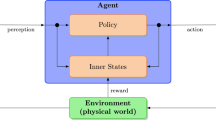Abstract
In 1950, Turing suggested a test to determine whether a computer can exhibit intelligent behaviour indistinguishable from that of a human. An aspect of the test was an imaginary conversation between a human and a computer. Since then, computer scientists have designed software to let humans interact with a computer in natural language. The first such program was ELIZA, designed in 1965. After ELIZA, numerous programs (christened Chatbots) have been written to enable humans to converse with computers in natural language. In this article, I describe several of them, including those that orally answer oral questions. I describe the latest program called ChatGPT, developed in late 2022, which has astounded everyone by its ability to answer questions posed in a natural language in any field and converse fluently with humans.
Similar content being viewed by others
Suggested Reading
Imperial War Museum, UK, How Alan Turing Cracked the Enigma Code.https://www.iwm.org.uk/history/how-alan-turing-cracked-the-enigma-code#:∼:text=With%20the%20help%20of%20captured,of%20all%20German%20naval%20signals.
A. M. Turing, Computing machinery and intelligence, Mind, 59, pp.433–60, October 1950. https://academic.oup.com/mind/article/LIX/236/433/986238.
J. Weizenbaum, ELIZA—A computer program for the study of natural language communication between man and machine, Com. ACM, Vol.9, No.1, pp.36–45, Jan 1966. https://doi.org/10.1145/365153.365168.
J. Weizenbaum, Computer Power and Human Reasoning, W. H. Freeman, San Francisco, 1976.
E. Adamopoulou, and L. Moussiades, Chatbots: History, technology, and applications, Machine Learning and Applications, Vol.2, December 2020, Elsevier. https://www.sciencedirect.com/science/article/pii/S2666827020300062#b107.
V. Cerf, PARRY encounters ELIZA, Based on a demonstration at ICCC 1972. https://datatracker.ietf.org/doc/html/rfc439.
ChatGPT Competitors Emerging in 2023, https://gigster.com/blog/5-chatgpt-competitors-emerging-in-2023/.
Caroline M. Nyce, Nine Chatbots you can play with right now, The Atlantic, March 28, 2023. https://www.theatlantic.com/technology/archive/2023/03/chatgpt-generative-ai-chatbots-bing-google-bard/673533
D.Gewirtz, How does ChatGPT Work? ZDNET, March 10,2023. https://www.zdnet.com/article/how-does-chatgpt-work/
J Grudin, ChatGPT and Chat History: Challenges for the New Wave, IEEE Computer, Vol.56, No.5, pp.94–100, May 2023.
Acknowledgment
I thank Prof. P.C.P. Bhatt, Dr. N.Dayasindhu, Prof. R. Govindarajan, and Prof. S.Ramani for reading this article and for their comments that improved it.
Author information
Authors and Affiliations
Corresponding author
Additional information
V. Rajaraman is at the Indian Institute of Science, Bengaluru. Several generations of scientists and engineers in India have learnt computer science using his lucidly written textbooks on programming and computer fundamentals. His current research interests are parallel computing and history of computing.
Rights and permissions
About this article
Cite this article
Rajaraman, V. From ELIZA to ChatGPT. Reson 28, 889–905 (2023). https://doi.org/10.1007/s12045-023-1620-6
Published:
Issue Date:
DOI: https://doi.org/10.1007/s12045-023-1620-6




